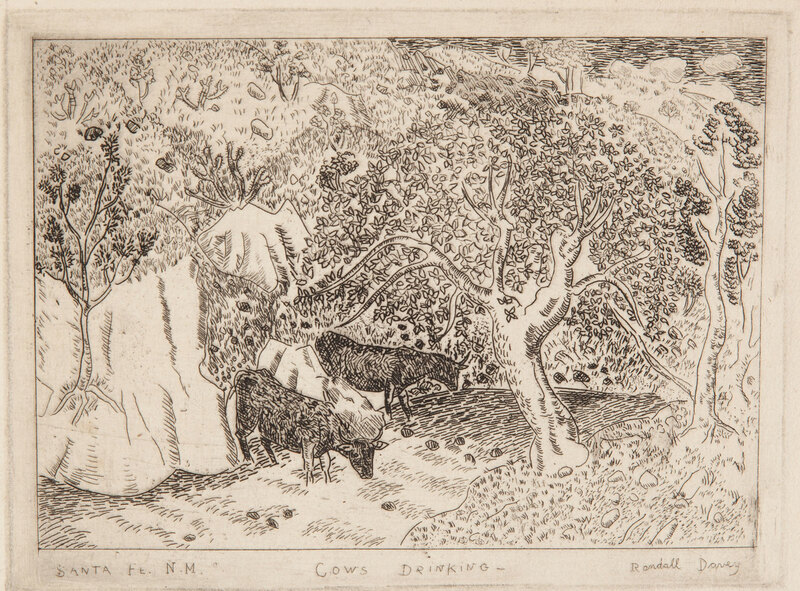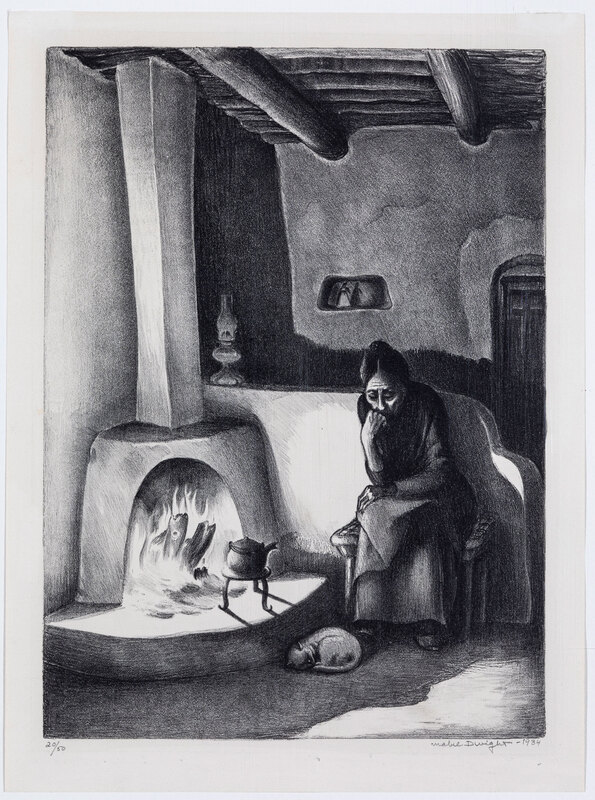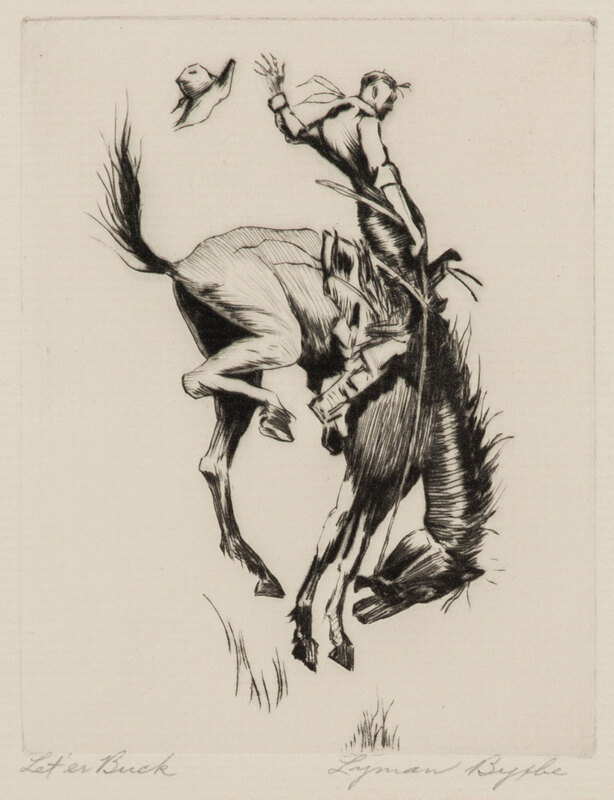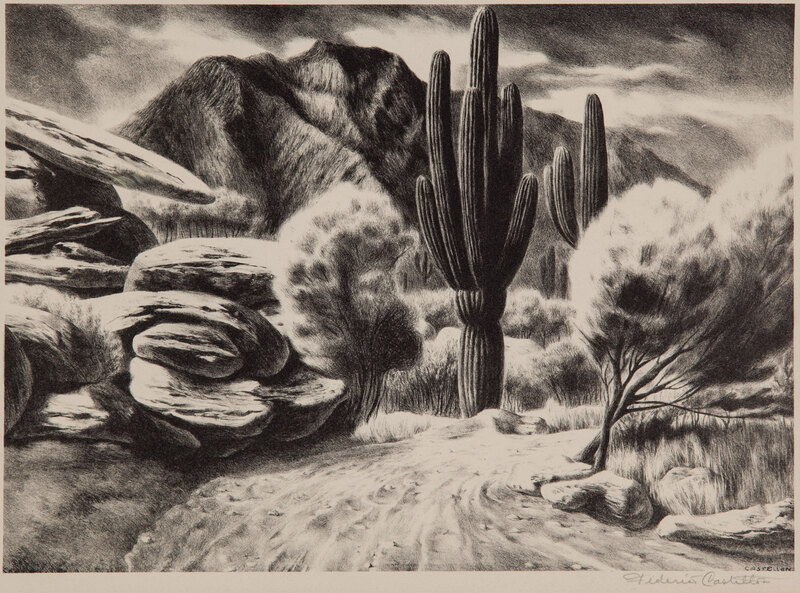The West
Notions of the West as open territory managed by cowboys was a late nineteenth-century phenomenon turned myth by the early twentieth century. Artists working under New Deal programs moved from cities to the West where they found a rich, seemingly untainted, multicultural landscape.
The West, a place both real and imagined, has long shaped the national identity of the United States. For centuries, American leaders described it—falsely—as an empty place ready to be conquered. After sending the Lewis and Clark Expedition to explore the territory acquired from France in the Louisiana Purchase, Thomas Jefferson (American, 1743 – 1826) wrote: “We shall delineate with correctness the great arteries of this great country: those who come after us will fill up the canvas we begin.” In the mid-19th century, Americans began celebrating “Manifest Destiny,” the idea that God had given the country an empty and rugged Western expanse to make it prosperous and to bestow the “gift” of White civilization on “less developed” or “savage” peoples.
But the enduring mythic image of “the West” filled with cowboys dates only to the late 19th century, after the American Civil War, when former Union and Confederate soldiers helped violently subdue indigenous groups with claims to Western lands, opening up vast regions for cattle grazing across the Midwest. The concurrent rise of industrialization drove the expansion of the railroads, mines and homesteads throughout the region. As the United States became more urbanized in the early 20th century, the mythology of the West grew stronger, as White Americans lamented the perceived loss of frontier ingenuity and independence.
The Great Depression had a huge impact on the American West—both on how Americans imagined it and how they lived in it. New Deal programs like the Works Progress Administration and the Civilian Conservation Corps built roads, bridges and buildings across the West and constructed huge dams, like the Grand Coulee Dam, to bring electricity to rural areas. The beginning of the Second World War also brought huge armaments factories to the region.
For artists, the West offered a new and exciting place of exploration and experimentation. New Deal artists’ programs, whose main purpose was to document everyday American life, sent artists who had trained in New York, Chicago, Paris or Munich to remote locations throughout the West and Southwest. There they discovered a rich multicultural world, and documented cowboys, White and Black homesteaders, Indigenous Americans, Mexican Americans and other groups. Gaining statehood in 1912, New Mexico in particular became an important destination for American artists between the First and Second World Wars. Several influential figures moved to or spent significant time in the state in the late 1910s, including the artist Robert Henri (American, 1865 – 1929) and the art patron Mabel Dodge Luhan (American, 1879 – 1962). The continued presence of Native Americans, including the Pueblo, as well as the legacy of Spanish colonialism and the striking natural beauty of New Mexico and the broader Southwest, offered artists unique, “exotic” and supposedly “authentic” subject matter, seemingly untainted by modern life. Female artists particularly thrived in the Southwest because they could live, work and even love outside of strict gender norms.
––CCG
Randall Davey (American, 1887 – 1964)
"Cows Drinking" from Ten Etchings Made in New Mexico, 1921
etching; 6 x 8 ½”
Binghamton University Art Museum, 2016.4.274
gift of Gil and Deborah Williams
Interpretive text has not been prepared for this object.
Randall Davey (American, 1887 – 1964)
"Penitentes Whipping" from Ten Etchings Made in New Mexico, 1921
etching; 8 ½ x 12”
Binghamton University Art Museum. 2016.4.275
gift of Gil and Deborah Williams
Randall Davey was born in New Jersey and joined the flourishing art community in New Mexico in 1920, converting an old mill outside Santa Fe into his home. Santa Fe reminded him of Spain, where he had toured in the 1910s while studying art under Robert Henri (American, 1865 – 1929). His preference for Spain led him to largely paint Hispanic subjects, rather than the local Pueblo Indians, who were a common subject for other New Mexico artists.
In this etching, Davey captured the Penitentes, a lay Catholic group that developed in the Southwest in the early 19th century. One of their rituals is to whip themselves in atonement for their sins during Lent—the two men on the left are holding braided whips, probably made of amole weed or yucca stalks—a practice called self-flagellation and introduced into the Americas by the Spanish in the 16th and 17th centuries.
––CCG
Mabel Dwight (American, 1876 – 1955)
New Mexico Interior, 1934
lithograph; 13 ½ x 9 ¾”
Roberson Museum and Science Center, 1984R45
Mabel Dwight was born in Cincinnati, Ohio and studied as a painter before learning lithography in her early fifties during a trip to Paris. In the 1930s, she worked for the Federal Art Project and produced over two dozen prints. She became best-known for her portrayal of New York City denizens, capturing the highs and lows of everyday life. She used her art to make social commentary that condemned, among other things, the structural issues of poverty in the US.
Dwight brought her keen eye and empathetic sensibility to this lithograph, which depicts a woman sitting alone by a fire in an adobe home in New Mexico. The shadows on the woman’s face suggests worry, and the stark composition emphasizes her loneliness. Dwight produced this piece for the Public Works of Art Project, probably inspired by a brief stay in New Mexico in 1929 or 1930.
––CCG
Jon Corbino (American, 1905 – 1964)
Escaped Bull, 1937
lithograph; 14 ¼ x 18”
Binghamton University Art Museum, 2016.4.104
gift of Gil and Deborah Williams
Interpretive text has not been prepared for this object.
Lyman Byxbe (American, 1886 – 1980)
Let’er Buck, 1937
engraving; 7 ¾ x 6 ¼”
Binghamton University Art Museum, 2016.4.61
gift of Gil and Deborah Williams
Born in Pittsfield, Illinois, Lyman Byxbe became well-known in the 1920s for the art he produced in Omaha, Nebraska and Estes Park, Colorado, especially his landscapes of the Rocky Mountains and images of farm life. This piece was produced in 1937, the same year he had a major exhibit at the Smithsonian Institution.
In the engraving, a cowboy, with one hand raised to the sky and his hat flying off behind him, struggles to keeps steady control of a bucking horse. He wears the traditional uniform of his trade—boots, a bandana tied around his neck and a Western shirt. The dynamic cowboy, able to subdue animal and landscape alike, was an essential masculine symbol of the American West in the 1930s, and remains so today. In 2007, Wyoming chose a very similar image for its state quarter.
––CCG
Adolf Dehn (American, 1895 – 1968)
Western Sunflowers (or Colorado Sunflowers), 1941
lithograph; 11 ¾ x 15 ¾”
Binghamton University Art Museum, 2016.4.178
gift of Gil and Deborah Williams
Interpretive text has not been prepared for this object.
Federico Castellón (American, born Spain, 1914 – 1971)
Road in Arizona, ca. 1941
lithograph; 11 ½ x 15 ¾”
Binghamton University Art Museum, 2016.4.411
gift of Gil and Deborah Williams
Interpretive text has not been prepared for this object.






